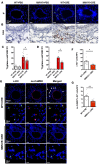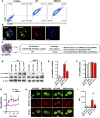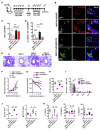Oxidized CaMKII promotes asthma through the activation of mast cells
- PMID: 28097237
- PMCID: PMC5214090
- DOI: 10.1172/jci.insight.90139
Oxidized CaMKII promotes asthma through the activation of mast cells
Abstract
Oxidation of calmodulin-dependent protein kinase II (ox-CaMKII) by ROS has been associated with asthma. However, the contribution of ox-CaMKII to the development of asthma remains to be fully characterized. Here, we tested the effect of ox-CaMKII on IgE-mediated mast cell activation in an allergen-induced mouse model of asthma using oxidant-resistant CaMKII MMVVδ knockin (MMVVδ) mice. Compared with WT mice, the allergen-challenged MMVVδ mice displayed less airway hyperresponsiveness (AHR) and inflammation. These MMVVδ mice exhibited reduced levels of ROS and diminished recruitment of mast cells to the lungs. OVA-activated bone marrow-derived mast cells (BMMCs) from MMVVδ mice showed a significant inhibition of ROS and ox-CaMKII expression. ROS generation was dependent on intracellular Ca2+ concentration in BMMCs. Importantly, OVA-activated MMVVδ BMMCs had suppressed degranulation, histamine release, leukotriene C4, and IL-13 expression. Adoptive transfer of WT, but not MMVVδ, BMMCs, reversed the alleviated AHR and inflammation in allergen-challenged MMVVδ mice. The CaMKII inhibitor KN-93 significantly suppressed IgE-mediated mast cell activation and asthma. These studies support a critical but previously unrecognized role of ox-CaMKII in mast cells that promotes asthma and suggest that therapies to reduce ox-CaMKII may be a novel approach for asthma.
Conflict of interest statement
M.E. Anderson is a cofounder of Allosteros Therapeutics, a biotech company aiming to develop CaMKII-based therapies.
Figures








Similar articles
-
Functional role of kynurenine and aryl hydrocarbon receptor axis in chronic rhinosinusitis with nasal polyps.J Allergy Clin Immunol. 2018 Feb;141(2):586-600.e6. doi: 10.1016/j.jaci.2017.06.013. Epub 2017 Jul 6. J Allergy Clin Immunol. 2018. PMID: 28689792 Free PMC article.
-
IgE production in CD40/CD40L cross-talk of B and mast cells and mediator release via TGase 2 in mouse allergic asthma.Cell Signal. 2013 Jun;25(6):1514-25. doi: 10.1016/j.cellsig.2013.03.010. Epub 2013 Mar 22. Cell Signal. 2013. PMID: 23524335
-
CaMKII is essential for the proasthmatic effects of oxidation.Sci Transl Med. 2013 Jul 24;5(195):195ra97. doi: 10.1126/scitranslmed.3006135. Sci Transl Med. 2013. PMID: 23884469 Free PMC article.
-
Role of IgE in the development of allergic airway inflammation and airway hyperresponsiveness--a murine model.Allergy. 1999 Apr;54(4):297-305. doi: 10.1034/j.1398-9995.1999.00085.x. Allergy. 1999. PMID: 10371087 Review.
-
The roles of sphingosine-1-phosphate in asthma.Mol Immunol. 2002 Sep;38(16-18):1239-45. doi: 10.1016/s0161-5890(02)00070-6. Mol Immunol. 2002. PMID: 12217390 Review.
Cited by
-
miR-155 Modulates Cockroach Allergen- and Oxidative Stress-Induced Cyclooxygenase-2 in Asthma.J Immunol. 2018 Aug 1;201(3):916-929. doi: 10.4049/jimmunol.1701167. Epub 2018 Jul 2. J Immunol. 2018. PMID: 29967100 Free PMC article.
-
RhoA/Rho-kinases in asthma: from pathogenesis to therapeutic targets.Clin Transl Immunology. 2020 Apr 29;9(5):e01134. doi: 10.1002/cti2.1134. eCollection 2020 May. Clin Transl Immunology. 2020. PMID: 32355562 Free PMC article. Review.
-
miR-511-3p protects against cockroach allergen-induced lung inflammation by antagonizing CCL2.JCI Insight. 2019 Oct 17;4(20):e126832. doi: 10.1172/jci.insight.126832. JCI Insight. 2019. PMID: 31536479 Free PMC article.
-
Autophagy/Mitophagy in Airway Diseases: Impact of Oxidative Stress on Epithelial Cells.Biomolecules. 2023 Aug 4;13(8):1217. doi: 10.3390/biom13081217. Biomolecules. 2023. PMID: 37627282 Free PMC article. Review.
-
Type II alveolar epithelial cell-specific loss of RhoA exacerbates allergic airway inflammation through SLC26A4.JCI Insight. 2021 Jul 22;6(14):e148147. doi: 10.1172/jci.insight.148147. JCI Insight. 2021. PMID: 34101619 Free PMC article.
References
-
- Jarjour NN, Calhoun WJ. Enhanced production of oxygen radicals in asthma. J Lab Clin Med. 1994;123(1):131–136. - PubMed
Publication types
MeSH terms
Substances
Grants and funding
LinkOut - more resources
Full Text Sources
Other Literature Sources
Medical
Molecular Biology Databases
Miscellaneous

